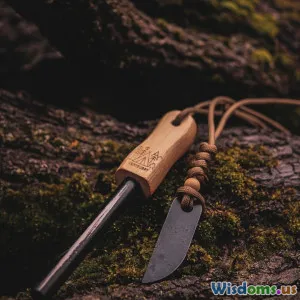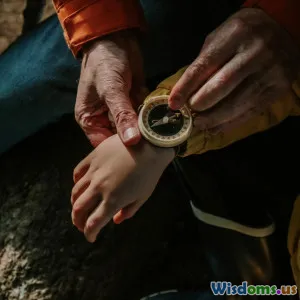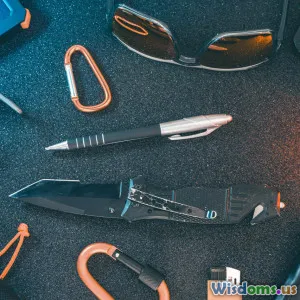
Can Modern Tech Compete with Primitive Survival Tools
8 min read Explore whether modern technology can truly replace primitive survival tools in wilderness adventure and survival situations. (0 Reviews)
Can Modern Tech Compete with Primitive Survival Tools?
When plunged into the raw, untamed wilderness, the question arises: Can the sleek precision of modern gadgets outmatch the tried-and-true resilience of primitive survival tools? This debate isn't just academic—it affects every outdoor adventurer, survivalist, and nature enthusiast who must choose how best to prepare for the unpredictable.
In this in-depth exploration, we'll compare the fundamental strengths of primitive survival tools with cutting-edge modern technology, revealing whether the latest gear truly holds the key to thriving in the wild or if ancient wisdom and simplicity remain unbeatable.
The Timeless Value of Primitive Survival Tools
Primitive survival tools refer to those instruments and methods developed by our ancestors, often constructed from natural materials found in the environment—wood, stone, bone, and plant fibers. Their designs evolved through millennia of trial and error, demonstrating a remarkable balance between effectiveness, simplicity, and sustainability.
Durability and Reliability
One core advantage of primitive tools is their durability without dependency on external resources such as batteries or electricity. For example, a stone hand axe or a bone needle doesn’t malfunction due to a depleted power source or software glitch; it’s ready to perform whenever held in skilled hands.
Consider the bow drill fire-starting method—an age-old technique that skilled survivalists still use today to summon fire by friction alone. A recent study published in the International Journal of Wilderness Recovery showed that trained individuals could reliably start fires using this method even after hours of practice in adverse conditions, underscoring its reliability.
Multi-Functional and Low-Tech
Primitive tools often serve multiple purposes. A sharpened stick can become a spear for hunting, a digging tool for tubers, or a lever to build shelter. The intrinsic adaptability offered by such simple designs can be an advantage when carrying minimal gear, as in ultralight backpacking or survival scenarios.
“Primitive technology forces you to understand and work with nature, which many modern gadgets abstract away,” says ethnobotanist Dr. Alan Webb. “It’s the ultimate form of survival integration.”
The Promise and Pitfalls of Modern Technology in Survival
The 21st century has introduced an arsenal of high-tech survival gadgets: satellite communicators, GPS-enabled watches, multi-tool kits, water filtration systems, and even compact solar panels to recharge USB-powered devices.
Enhanced Navigation and Communication
Today, GPS devices can pinpoint your location within meters anywhere globally, a feat unimaginable to adventurers just decades ago. Emergency beacons and satellite messengers allow users to summon help with the press of a button, increasing the survival chances after accidents.
For instance, in 2022, rescue teams credited a Garmin inReach satellite device with locating four hikers lost in the Alaskan wilderness under severe weather, demonstrating modern technology's remarkable life-saving potential.
Improved Comfort and Efficiency
Water purification technologies—such as portable UV sterilizers (e.g., SteriPEN)—provide quick and effective ways to ensure safe drinking water without boiling for extended periods. Lightweight synthetic sleeping bags, compact stoves, and weather-resistant materials vastly improve survival odds and comfort.
Dependency and Vulnerabilities
Despite these advantages, modern tech tools come with downsides. Devices can fail—electronics suffer from battery depletion, water damage, and mechanical faults. Moreover, the “black box” nature of many devices leaves users unable to repair or understand failures in critical moments.
“Relying solely on technology can create a dangerous false sense of security,” warns survival instructor Lisa Bergstrom. “If your GPS dies and you lost traditional navigation skills, it could turn quickly from convenience to liability.”
Direct Comparisons: Primitive versus Tech in Key Survival Tasks
Fire Making
Primitive: Bow drills and flint-and-steel require knowledge and physical effort but never run out of fuel.
Modern: Lighters or electronic igniters are quick and low effort but require fuel or batteries.
Navigation
Primitive: Celestial navigation or natural indicators like moss growth.
Modern: GPS devices provide instant accuracy but rely on power sources.
Water Purification
Primitive: Boiling (needs fire, fuel).
Modern: UV sterilizers, chemical purifiers offer speed, convenience but need power or supplies.
Shelter
Primitive: Building from natural materials requires skill but uses what’s available.
Modern: Lightweight tents provide quick shelter but must be carried.
Real-World Insight: When Both Worlds Meet
Modern survival experts emphasize a hybrid approach.
Edmund Kay, an experienced wilderness guide, notes, “I carry GPS and satellite phones but also practice flint knapping and map reading. When one tool fails, the other takes over." This redundancy maximizes survival probabilities.
In survival competitions like the “World Survival Games,” contestants' use of primitive tools alongside modern gadgets reveals a pragmatic appreciation for diverse methods. Contestants who depend only on technology often struggle when devices malfunction, proving old techniques remain invaluable.
Conclusion: The Best of Both Worlds
Modern technology undoubtedly enhances many aspects of survival training and real-world outdoor adventures, offering unparalleled convenience, safety, and efficiency. Yet, primitive survival tools root us in timeless skills that foster resilience, self-sufficiency, and adaptability.
Rather than viewing these methods in opposition, the savvy adventurer embraces their complementary strengths. Developing skills in both areas not only honors the wisdom of our ancestors but also leverages modern innovation to better navigate and endure the unpredictable wild.
So, can modern tech compete with primitive survival tools? The answer may not be competition but cooperation, blending tradition’s enduring legacy with today's technological advances to safeguard our adventurous spirit.
References
- International Journal of Wilderness Recovery, 2021, "Fire Making Techniques and Survival Efficiency"
- L. Bergstrom, "Survival Myths and Realities," Outdoor Skills Quarterly, 2023
- Interview with Dr. Alan Webb, Ethnobotany Today, 2023
- Rescue Alaska 2022 Annual Report
Embark equipped—not just with the latest gadgetry but with time-tested survival wisdom, ensuring that whether tech succeeds or fails, your spirit and skills endure.
Rate the Post
User Reviews
Popular Posts



















